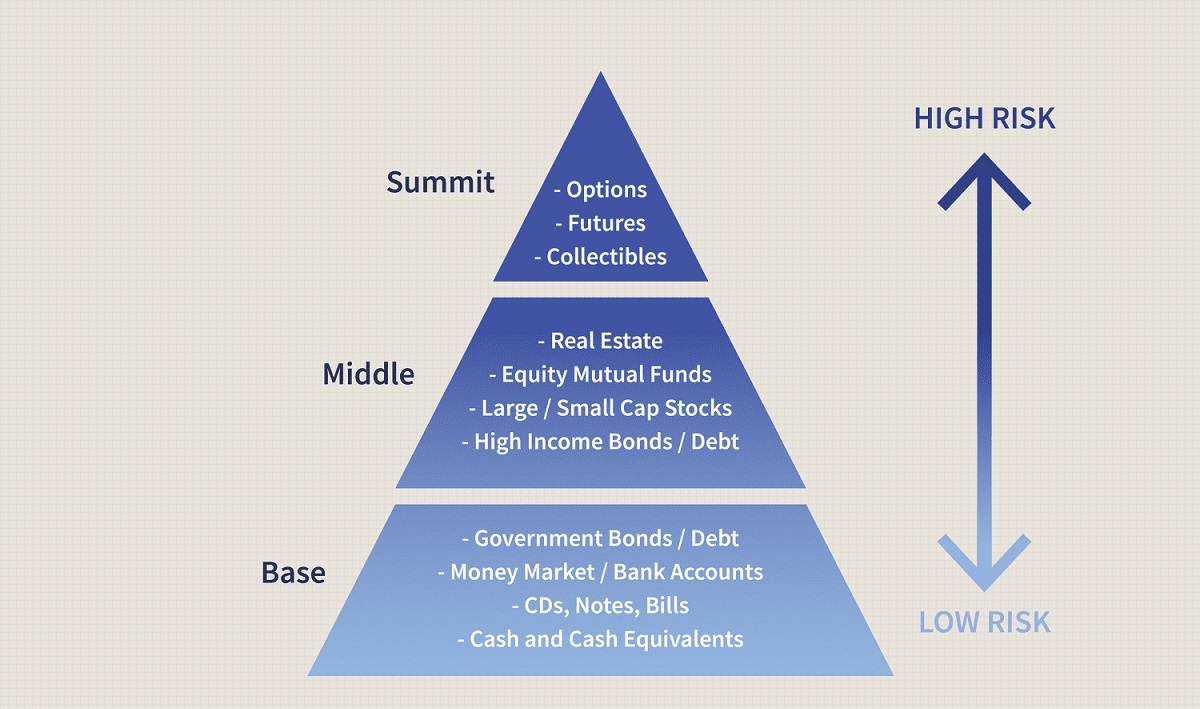Introduction
Welcome to the world of investing! Whether you’re just starting out or looking to reallocate your investments, understanding how to allocate your investments is a crucial step towards building a successful financial future. By effectively allocating your investments, you can optimize your portfolio’s performance and minimize your risk exposure.
Investment allocation refers to the process of dividing your investment capital among different asset classes, such as stocks, bonds, real estate, and cash. The goal is to create a diversified portfolio that can potentially generate returns while mitigating the impact of market volatility.
Determining the right investment allocation strategy requires careful consideration of various factors, including your risk tolerance, investment goals, time horizon, and market conditions. It’s important to approach investment allocation with a clear understanding of your financial situation and objectives.
In this guide, we will explore the key principles of investment allocation and provide you with practical tips to help you make informed decisions. From assessing your risk tolerance to balancing asset classes, we’ll cover the essential steps you need to take in order to allocate your investments effectively.
However, it is important to note that investment allocation is a personalized process, and there is no one-size-fits-all solution. What works for one investor may not work for another. Therefore, it’s crucial to educate yourself on the available options and seek professional advice if needed to tailor an investment allocation strategy that aligns with your individual needs and goals.
Now, let’s dive into the world of investment allocation and discover how you can maximize your investment returns while minimizing risk!
Assessing Your Risk Tolerance
Before you begin allocating your investments, it’s important to assess your risk tolerance. Risk tolerance refers to your ability and willingness to endure the ups and downs of the market. This is a crucial factor in determining the appropriate allocation of your investments.
Assessing your risk tolerance involves understanding your financial goals, time horizon, and your emotional response to investment volatility. Consider your investment objectives—are you investing for long-term growth or short-term gains? Are you comfortable with the possibility of losing money in pursuit of higher returns?
One way to determine your risk tolerance is by considering your age and proximity to retirement. Typically, younger investors have a longer time horizon and can afford to take on higher levels of risk in pursuit of greater returns. On the other hand, older individuals who are nearing retirement may have a lower risk tolerance and prioritize capital preservation.
Another factor to consider is your financial stability and ability to withstand potential losses. If you have a secure income, emergency savings, and a lower need for immediate liquidity, you may be more comfortable with a higher-risk allocation. However, if you have limited financial resources and rely heavily on your investments for income, a more conservative approach may be appropriate.
Furthermore, it’s important to assess your emotional tolerance for market fluctuations. Are you easily swayed by short-term market volatility? Or are you able to stay focused on your long-term investment goals during turbulent times? Understanding your emotional response to market conditions can help you determine the level of risk you are comfortable with.
There are various tools and questionnaires available online that can help you assess your risk tolerance. These resources typically ask a series of questions about your investment preferences, financial situation, and emotional reactions to market fluctuations.
By evaluating your risk tolerance, you can gain a better understanding of the level of risk you are comfortable with, which will inform your investment allocation decisions. Remember, it’s crucial to be honest with yourself and not take on more risk than you can handle, as this can lead to poor decision-making and potential financial stress.
Now that we’ve discussed the importance of assessing your risk tolerance let’s move on to the next step: diversification.
Diversification: The Key to Investment Allocation
When it comes to investment allocation, diversification is a fundamental principle that can help manage risk and maximize returns. It is the practice of spreading your investments across different asset classes, industries, and geographic regions.
The main goal of diversification is to create a portfolio that is not overly concentrated in one particular investment or asset class. By diversifying your investments, you reduce the reliance on any single investment to generate returns. This can help protect your portfolio from significant losses if one investment performs poorly.
There are several ways to achieve diversification within your investment portfolio. Firstly, you can diversify by asset class. Common asset classes include stocks, bonds, real estate, and cash. Each asset class has its own risk and return characteristics, and they tend to perform differently under various market conditions. By allocating your investments across these different asset classes, you can spread your risk and potentially enhance returns.
Next, you can diversify within each asset class. For example, within the stock market, you can invest in different industries such as technology, healthcare, or consumer goods. This way, even if one industry experiences a downturn, other industries may perform well and offset the losses.
Furthermore, geographic diversification involves investing in companies or assets in different countries or regions. This can help protect your portfolio from being heavily influenced by the economic conditions of a single country or region. By spreading your investments across multiple countries, you reduce the impact of any single country’s economic downturn on your portfolio.
Additionally, diversifying by investment style can be beneficial. This involves investing in a mix of growth stocks and value stocks. Growth stocks are typically companies that are expected to grow at an above-average rate, while value stocks are companies that are undervalued and have the potential for future growth. By diversifying between these two styles, you can capture opportunities in both types of companies.
It’s important to note that diversification does not guarantee profits or protect against all losses. However, it can help to reduce risk and potentially increase the likelihood of achieving your investment objectives.
When implementing a diversification strategy, it’s important to regularly review your portfolio to ensure it remains diversified. Over time, certain investments may outperform or underperform, which can lead to imbalances in your portfolio. Rebalancing your portfolio periodically can help you maintain your desired asset allocation.
In summary, diversification is key to effective investment allocation. By spreading your investments across different asset classes, industries, and geographic regions, you can reduce risk and potentially enhance your investment returns. The next section will delve into understanding different types of investments to further assist you in allocating your investments effectively.
Understanding Different Types of Investments
When it comes to investment allocation, it’s important to have a sound understanding of the different types of investments available. Each investment type has its own risk and return characteristics, and by diversifying across these different options, you can create a well-rounded portfolio that suits your investment goals and risk tolerance.
1. Stocks: Stocks represent ownership in a corporation. When you buy shares of a company’s stock, you become a partial owner and have the potential to benefit from the company’s growth and profitability. Stocks offer the potential for high returns but also come with higher volatility and risk compared to other investment options.
2. Bonds: Bonds are debt securities issued by governments, municipalities, corporations, and other entities. When you buy a bond, you are essentially lending money to the issuer in exchange for periodic interest payments and the return of your principal at maturity. Bonds are generally considered less risky than stocks and provide a steady stream of income but may offer lower returns in the long run.
3. Real Estate: Investing in real estate involves purchasing properties or investing in real estate investment trusts (REITs), which are companies that own and manage income-generating real estate properties. Real estate investments can offer a combination of income and potential appreciation, and they are considered a tangible and less volatile asset class.
4. Mutual Funds: Mutual funds pool money from multiple investors to invest in a diversified portfolio of stocks, bonds, or other assets. They are managed by professional fund managers and offer individual investors access to a diverse range of investments without requiring large sums of money. Mutual funds can provide instant diversification and are suitable for investors seeking a hands-off approach to investment allocation.
5. Exchange-Traded Funds (ETFs): Similar to mutual funds, ETFs also pool money from investors to create a diversified portfolio of assets. However, ETFs trade on stock exchanges like individual stocks, allowing investors to buy and sell them throughout the trading day at market prices. ETFs offer flexibility, lower costs, and tax advantages compared to traditional mutual funds.
6. Commodities: Commodities include natural resources like gold, silver, oil, and agricultural products. Investing in commodities can provide a hedge against inflation and diversification benefits, as they have a low correlation with traditional asset classes. However, commodities can be highly volatile, and investing in them requires a good understanding of the market dynamics.
7. Cash and Cash Equivalents: Cash and cash equivalents, such as savings accounts, certificates of deposit (CDs), and money market funds, offer liquidity and stability. While they do not provide significant returns, they are important for maintaining an emergency fund and for short-term financial needs.
It’s important to note that this is not an exhaustive list of all investment options available. Other investment vehicles, such as options, futures, and cryptocurrencies, also exist, but they typically involve higher risks and require more specialized knowledge.
When allocating your investments, it’s crucial to consider your risk tolerance, time horizon, and investment goals. A well-diversified portfolio usually includes a mix of different investment types to balance risk and potential returns. By understanding the characteristics of each investment option, you can make informed decisions and create a portfolio that aligns with your financial objectives.
Next, we will dive into the importance of balancing asset classes in your investment allocation strategy.
Balancing Asset Classes
One of the critical factors to consider when allocating your investments is balancing asset classes. Balancing asset classes involves determining the appropriate allocation percentages for different types of investments within your portfolio. This allocation is based on your risk tolerance, investment goals, and time horizon.
Asset classes, such as stocks, bonds, real estate, and cash, have different risk and return characteristics. They also tend to perform differently under various market conditions. Balancing asset classes helps in diversifying your portfolio and spreading the risk across different investments.
There is no one-size-fits-all approach to asset class balancing, as it varies based on individual circumstances and preferences. Generally, the allocation of assets is categorized into conservative, balanced, and aggressive portfolios.
Conservative portfolios typically have a higher allocation to low-risk assets, such as bonds and cash. These portfolios prioritize capital preservation and stable income generation. They are suitable for investors with a low-risk tolerance and shorter investment time horizons.
On the other hand, aggressive portfolios have a higher allocation to high-risk assets, such as stocks and real estate. These portfolios aim for higher potential returns and are suitable for investors with a high-risk tolerance and longer investment time horizons.
For most investors, a balanced portfolio is a common choice. It includes a mix of various asset classes to strike a balance between risk and potential returns. A balanced portfolio typically consists of a combination of stocks, bonds, and possibly real estate or other alternative investments, based on individual preferences and goals.
One common rule of thumb for asset class balancing is the “100-minus-age” rule. According to this rule, you subtract your age from 100 to determine the percentage of your portfolio that should be allocated to stocks. The remaining percentage is then allocated to bonds and other asset classes. For example, if you are 30 years old, you may allocate 70% of your portfolio to stocks and 30% to bonds. This rule provides a starting point, but it’s important to consider other factors such as risk tolerance and financial goals.
Asset class balancing is not a one-time decision. It requires regular monitoring and adjustments as market conditions and individual circumstances change. Rebalancing your portfolio periodically is crucial to maintaining your desired asset allocation. This involves selling some investments that have performed well and buying more of the underperforming assets to bring your portfolio back into balance.
Remember to review and adjust your asset allocation periodically to ensure that it aligns with your changing financial situation and goals. Working with a financial advisor can be beneficial in helping you determine the optimal asset allocation for your portfolio.
Now that we have discussed the importance of balancing asset classes, let’s move on to understanding the suitable investment time horizon for your investments.
Determining the Suitable Investment Time Horizon
Determining the suitable investment time horizon is a crucial step in allocating your investments. Your investment time horizon refers to the length of time you plan to hold your investments before needing to access the funds. It plays a vital role in determining the appropriate asset allocation and investment strategy.
Your investment time horizon is influenced by various factors, including your financial goals and upcoming expenses. It could range from short-term (less than five years) to medium-term (five to ten years) to long-term (more than ten years).
Short-term goals typically involve expenses that will occur within the next few years, such as saving for a down payment on a house or funding a dream vacation. When your investment time horizon is short, it is generally advisable to prioritize capital preservation and liquidity. Low-risk investments, such as cash and short-term bonds, may be more suitable for short-term goals to ensure the funds are readily available when needed.
Medium-term goals may include saving for a child’s education, funding a major home renovation, or starting a business. With a medium-term investment time horizon, there is more leeway to consider investments that have the potential for higher returns. It may be appropriate to allocate a portion of your portfolio to a mix of stocks, bonds, and real estate to strike a balance between risk and reward.
Long-term goals often include retirement planning and building wealth over an extended period. When your investment time horizon is long, you have more time to ride out market fluctuations and can afford to take on more risk in pursuit of potentially higher returns. This may involve allocating a larger portion of your portfolio to stocks and other growth-oriented investments.
It’s important to note that investment time horizons can be flexible and may vary for different goals within your overall financial plan. For example, you may have a long-term investment horizon for retirement savings but a short-term horizon for saving for a down payment on a home.
As you determine your investment time horizon, it’s crucial to consider your risk tolerance as well. Longer time horizons generally allow for a higher risk tolerance, as there is more time to recover from market downturns. However, your risk tolerance should always align with your comfort level and financial goals.
Regularly reassessing your investment time horizon is essential, as your goals and circumstances may change over time. For example, as you approach retirement, your investment time horizon may shift to a more conservative approach to protect your wealth.
In summary, determining the suitable investment time horizon is a critical step in allocating your investments effectively. It influences your asset allocation and investment strategy, ensuring that your investment goals are aligned with your time frame. By understanding your investment time horizon, you can make informed decisions that best suit your financial needs and goals.
Next, let’s explore the importance of revisiting and rebalancing your investment portfolio.
Revisiting and Rebalancing Your Investment Portfolio
Once you have allocated your investments and established your asset allocation, it’s important to regularly revisit and rebalance your investment portfolio. Revisiting and rebalancing ensures that your portfolio remains aligned with your investment goals and maintains the desired asset allocation.
Market movements can cause your asset allocation to deviate from your original plan. Certain asset classes may outperform others, leading to an overweight position in those assets. Similarly, some assets may underperform, resulting in an underweight position. Regularly reviewing your portfolio allows you to identify any imbalances and take necessary steps to rebalance.
Rebalancing involves buying or selling assets within your portfolio to restore your desired asset allocation. For example, if stocks have performed well and now constitute a larger percentage of your portfolio than desired, you may sell some stocks to rebalance and buy additional bonds or other assets to bring the allocation back in line with your target percentages.
Rebalancing is important for several reasons:
1. Maintaining Risk Levels: Rebalancing helps you maintain the risk level that aligns with your risk tolerance and investment goals. Without periodic rebalancing, your portfolio may become more volatile if one asset class becomes dominant, increasing your exposure to its risk factors.
2. Capturing Gains: Rebalancing allows you to lock in gains from investments that have performed well and redistribute those gains to other assets. It helps you prevent concentrating too much in one area and potentially missing out on gains in other areas.
3. Restoring Diversification: Rebalancing ensures that you maintain a diversified portfolio. By regularly reviewing and adjusting the allocation percentages, you can ensure that each asset class continues to contribute to the overall diversification and risk management of your portfolio.
It’s important to note that rebalancing should not be done too frequently, as it can result in unnecessary transaction costs and potentially hinder long-term investment performance. On the other hand, rebalancing should not be neglected for too long, as it can lead to a portfolio that no longer reflects your risk tolerance or investment goals.
Consider rebalancing your portfolio on a predetermined schedule, such as annually or semi-annually, or when there is a significant deviation from your target asset allocation. However, it’s always important to evaluate your portfolio in the context of your specific circumstances and consult with a financial advisor if needed.
Regularly revisiting your investment portfolio beyond rebalancing is also essential. This involves evaluating the performance of your investments, assessing whether they meet your expectations, and considering any changes in your financial situation or goals that may warrant adjustments to your investment strategy.
Remember, investing is a long-term endeavor, and your investment portfolio should be aligned with your evolving financial needs and goals. Regularly reviewing and rebalancing your portfolio ensures that it remains on track to help you achieve your desired outcomes.
Now that we have discussed the importance of revisiting and rebalancing your investment portfolio, let’s explore the impact of taxes and inflation on your investments.
Assessing the Impact of Taxes and Inflation
When allocating your investments, it’s crucial to assess the impact of taxes and inflation on your portfolio. Taxes and inflation can erode the real value of your investments over time if not taken into consideration.
1. Taxes: Taxes can significantly impact your investment returns. Different types of investments may be subject to various tax treatments, such as capital gains tax, dividends tax, or interest income tax. It’s important to understand the tax implications of your investments and consider tax-efficient strategies to minimize the impact.
One tax-efficient strategy is to utilize tax-advantaged accounts, such as Individual Retirement Accounts (IRAs) or 401(k) plans, which offer tax advantages such as tax-deferred growth or tax-free withdrawals. By contributing to these accounts, you can potentially reduce your taxable income and allow your investments to grow tax-free or tax-deferred.
Another strategy is tax-loss harvesting, which involves selling investments that have experienced a loss to offset capital gains and potentially reduce your tax liability.
2. Inflation: Inflation refers to the general increase in prices over time, which erodes the purchasing power of money. When inflation outpaces the rate of return on your investments, your investment gains may not be enough to maintain the same real value.
To assess the impact of inflation, it’s important to consider investments that have the potential to provide returns that outpace inflation. Historically, stocks have tended to outperform inflation over the long term, making them a popular choice for investors seeking to combat the effects of inflation.
Additionally, investing in assets that have a hedge against inflation, such as real estate, commodities, or inflation-protected securities (e.g., Treasury Inflation-Protected Securities or TIPS), can help preserve your purchasing power over time.
Understanding the impact of taxes and inflation can help you make more informed investment decisions and adjust your allocation strategy accordingly. It’s important to consult with a tax advisor or financial professional to gain insights into the specific tax implications of your investments and develop strategies that align with your overall financial plan.
Keep in mind that tax laws and inflation rates can change over time, so it’s crucial to stay informed and periodically review your investment strategy to account for any updates or adjustments that may be necessary.
Now that we have explored the impact of taxes and inflation, let’s discuss the importance of seeking professional advice for investment allocation.
Seeking Professional Advice for Investment Allocation
While allocating your investments can be done independently, seeking professional advice can provide valuable insights and expertise to help optimize your investment allocation strategy. Professional financial advisors or investment managers can offer guidance and support in aligning your portfolio with your financial goals and risk tolerance.
Here are a few reasons why seeking professional advice for investment allocation can be beneficial:
1. Expertise and Knowledge: Financial advisors have in-depth knowledge and expertise in various investment options, asset classes, market trends, and economic conditions. They can help you navigate the complex world of investing, analyze your financial situation, and develop a tailored investment allocation plan that suits your needs and goals.
2. Objective Perspective: Emotions can often cloud judgment when it comes to making investment decisions. A professional advisor can provide an objective perspective and help you make rational choices based on your long-term financial objectives rather than short-term market fluctuations. They can serve as a voice of reason during turbulent times and help you stay focused on your investment strategy.
3. Customized Approach: Every individual has unique financial circumstances, goals, and risk tolerance. A professional advisor can assess your specific situation and develop a customized investment allocation strategy that aligns with your goals. They can take into account factors such as your investment time horizon, tax situation, and the need for liquidity to create a personalized plan that suits your needs.
4. Regular Monitoring and Rebalancing: Professional advisors monitor your investment portfolio regularly, ensuring it remains aligned with your objectives. They can track market movements, analyze performance, and make necessary adjustments to rebalance your portfolio and maintain your desired asset allocation. This proactive approach helps you stay on track with your investment goals and potentially uncover new opportunities.
5. Insights and Education: Seeking professional advice provides an opportunity to expand your knowledge about investing and financial planning. Advisors can educate you on different investment options, risk management strategies, and the potential impact of economic factors on your portfolio. They can empower you to make informed decisions and build your financial literacy.
When selecting a financial advisor, it’s important to consider their qualifications, experience, and track record. Look for professionals who are registered and have a fiduciary duty to act in your best interest. Additionally, establish clear communication and ensure that their investment philosophy aligns with your goals and values.
While seeking professional advice comes with a cost, the potential benefits in terms of optimized investment allocation and peace of mind are often worth it. A professional advisor can serve as a trusted partner on your financial journey, helping you navigate the complexities of investing and increasing your chances of achieving your financial goals.
Now that we have explored the benefits of seeking professional advice for investment allocation, let’s summarize the key points we have covered in this guide.
Conclusion
Allocating your investments effectively is a crucial step towards building a successful financial future. By assessing your risk tolerance, diversifying your investments, understanding different asset classes, balancing asset allocation, considering your investment time horizon, and being mindful of taxes and inflation, you can make informed decisions that align with your financial goals and risk tolerance.
Assessing your risk tolerance allows you to understand the level of risk you are comfortable with and determine the appropriate allocation of your investments. Diversifying your investments across different asset classes helps manage risk and maximize returns. Understanding different types of investments allows you to select investments that align with your risk profile and investment objectives.
Balancing asset classes ensures that your portfolio remains diversified and aligns with your risk tolerance and goals. Determining your investment time horizon is essential in selecting investments with appropriate risk and return characteristics. Assessing the impact of taxes and inflation helps you manage tax liabilities and preserve the purchasing power of your investments over time.
Revisiting and rebalancing your investment portfolio on a regular basis ensures that your portfolio remains on track and aligned with your desired asset allocation. Seeking professional advice can provide valuable guidance, expertise, and an objective perspective in optimizing your investment allocation strategy.
Remember that investment allocation is a dynamic process and should be reviewed and adjusted as your financial situation and goals change. Regularly monitoring your portfolio, staying informed on market trends, and seeking professional advice when needed can help you make informed decisions and navigate the complexities of investing.
Ultimately, the goal of investment allocation is to maximize returns while managing risk and aligning with your financial objectives. By carefully considering these factors and making informed decisions, you can work towards achieving your financial goals and building a solid foundation for your future.

























